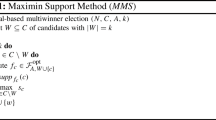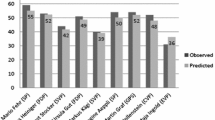Abstract
Multi-winner elections, for example, the election of members to a committee, are now quite common, and include the interesting subclass of elections with a variable number of winners, or VNW elections. In VNW elections, voters determine how many winners there are, as well as which candidates win. Common VNW elections include elections to bestow honorary status, such as enshrinement in a hall of fame, and elections to determine a shortlist of, say, job candidates for interviews. Such elections are VNW elections whenever the number of winners is not specified in advance. Multi-winner elections are often conducted by adapting standard procedures for single-winner elections. Approval balloting is particularly appropriate for multi-winner elections, as every ballot, and the set of winners, are subsets of the set of all candidates. Many methods of counting approval ballots appropriate to VNW elections are reviewed and illustrated, and their properties—desirable and undesirable—discussed.
Similar content being viewed by others
Notes
Note that the multi-winner elections studied here do not include elections designed to produce proportional representation.
References
Aziz, H., Brill, M., Conitzer, V., Elkind, E., Freeman, R., & Walsh, T. (2015). Justified representation in approval-based committee voting. https://users.cs.duke.edu/~conitzer/justifiedAAAI15. Accessed October 24, 2015.
Brams, S. J., & Fishburn, P. C. (1978). Approval voting. American Political Science Review, 72(3), 831–857.
Brams, S. J., & Fishburn, P. C. (1983). Approval voting. Cambridge, MA: Birkhäuser Boston.
Brams, S. J., & Kilgour, D. M. (2012). Narrowing the field in elections: the next-two rule. Journal of Theoretical Politics, 24(4), 507–525.
Brams, S. J., & Kilgour, D. M. (2014). Satisfaction approval voting. In R. Fara, D. Leech, & M. Salles (Eds.), Voting power and procedures: Essays in honour of Dan Felsenthal and Moshé Machover (pp. 323–346). Cham: Springer.
Brams, S. J., Kilgour, D. M., & Sanver, M. R. (2005). A minimax procedure for electing committees. Public Choice, 132(3–4), 401–420.
Fishburn, P. C., & Pekeč, A. (2004). Approval voting for committees: Threshold approaches. http://people.duke.edu/~pekec/Publications/CommitteeVotePekecFishburn. Accessed October 24, 2015.
Kilgour, D. M. (2016). Axioms for approval elections with a variable number of winners (unpublished manuscript).
Kilgour, D. M. (2010). Approval balloting for multi-winner elections. In J.-F. Laslier & M. R. Sanver (Eds.), Handbook on approval voting (pp. 105–124). Heidelberg: Springer.
Kilgour, D. M., Brams, S. J., & Sanver, M. R. (2006). How to elect a representative committee using approval balloting. In B. Simeone & F. Pukelsheim (Eds.), Mathematics and democracy: Recent advances in voting systems and collective choice (pp. 83–95). Heidelberg: Springer.
Kilgour, D. M., & Marshall, E. (2012). Approval balloting for fixed-size committees. In D. S. Felsenthal & M. Machover (Eds.), Electoral systems: Paradoxes, assumptions, and procedures (pp. 305–326). Heidelberg: Springer.
National Baseball Hall of Fame (BBHOF) (2015). Hall of fame election rules. http://baseballhall.org/hall-of-famers/bbwaa-rules-for-election. Accessed 24 Oct 2015.
Ratliff, T. C., & Saari, D. G. (2014). Complexities in electing diverse committees. Social Choice and Welfare, 43, 55–71.
Simmons, F. (2001). Proportional approval voting. https://www.mail-archive.com/election-methods-list@eskimo.com/msg04820.html. Accessed October 24, 2015.
Tideman, N. (2016). Multiple winner voting rules. In J. C. Heckelman & N. Miller (Eds.), Handbook of social choice and voting (pp. 303–323). Northampton, MA: Elgar.
Acknowledgments
Valuable comments from Steven J. Brams, Hannu Nurmi, and Arkadii Slinko are gratefully acknowledged.
Author information
Authors and Affiliations
Corresponding author
Rights and permissions
About this article
Cite this article
Kilgour, D.M. Approval elections with a variable number of winners. Theory Decis 81, 199–211 (2016). https://doi.org/10.1007/s11238-016-9535-2
Published:
Issue Date:
DOI: https://doi.org/10.1007/s11238-016-9535-2




